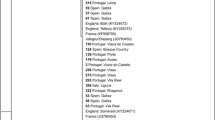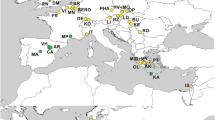Abstract
Concordance between the mitochondrial haplotypes of the Eastern honey bee, Apis cerana, and its ectoparasitic Varroa mites across the Isthmus of Kra in Thailand has suggested that local host–pathogen co-evolution may be responsible for the geographic distribution of particular genotypes. To investigate nuclear microsatellites population structure in A. cerana, single workers of A. cerana colonies from Thailand were genotyped at 18 microsatellite loci. The loci showed intermediate to high levels of heterozygosity and a range of allele numbers. The analyses confirmed a fundamental subdivision of the Thai A. cerana population into the “Asia Mainland” and “Sundaland” regions at the Isthmus of Kra. However, the nuclear microsatellite differentiation was less distinct than mtDNA haplotype differences, suggesting male-biased dispersal and population admixture. Overall, samples showed a weak isolation-by-distance effect. The isolated population on Samui island was most differentiated from the other samples. The results do not support our initial hypothesis of local host–pathogen co-evolution, which predicts a strict correspondence between the nuclear genome and the lineage of parasitic Varroa mite of the A. cerana samples, because the gene flow indicated by our nuclear microsatellite markers should also mix potential Varroa resistance alleles among subpopulations. Instead, our study suggests that the coincidental distribution of Varroa lineages and A. cerana population structure in Thailand are the result of biogeographic history and current migration patterns.



Similar content being viewed by others
References
Crozier Y.C., Koulianos S. and Crozier R.H. 1991. An improved test for Africanized honeybee mitochondrial DNA. Experientia 47: 968-969.
Damus M.S. and Otis G.W. 1997. A morphometric analysis of Apis cerana F and Apis nigrocincta Smith populations from Southeast Asia. Apidologie 28: 309-323.
de la Rua P., Simon U.E., Tilde A.C., Moritz R.F.A. and Fuchs S. 2000. MtDNA variation in Apis cerana populations from the Philippines. Heredity 84: 124-130.
Delaney D.A., Meixner M.D., Schiff N.M. and Sheppard W.S. 2009. Genetic characterization of commercial honey bee (Hymenoptera: Apidae) populations in the United States by using mitochondrial and microsatellite markers. Annls Entomol. Soc. Am. 102: 666-673.
Deowanish S., Nakamura J., Matsuka M. and Kimura K. 1996. MtDNA variation among subspecies of Apis cerana using restriction fragment length polymorphism. Apidologie 27: 407-413.
El-Niweiri M.A.A. and Moritz R.F.A. 2010. The impact of apiculture on the genetic structure of wild honeybee populations (Apis mellifera) in Sudan. J. Insect Cons. 14: 115-124.
Evanno G., Regnaut S. and Goudet J. 2005. Detecting the number of clusters of individuals using the software STRUCTURE: a simulation study. Mol. Ecol. 14: 2611-2620.
Hamilton W.D. 1980. Sex versus non-sex versus parasite. Oikos 35: 282-290.
Hepburn H.R., Smith D.R., Radloff S.E. and Otis G.W. 2001. Infraspecific categories of Apis cerana: morphometric, allozymal and mtDNA diversity. Apidologie 32: 3-23.
Hubisz M.J., Falush D., Stephens M. and Pritchard J.K. 2009. Inferring weak population structure with the assistance of sample group information. Mol. Ecol. Res. 9: 1322-1332.
Insuan S., Deowanish S., Klinbunga S., Sittipraneed S., Sylvester H.A. and Wongsiri S. 2007. Genetic differentiation of the giant honey bee (Apis dorsata) in Thailand analyzed by mitochondrial genes and microsatellites. Biochem. Gen. 45: 345-361.
Lively C.M. and Dybdahl M.F. 2000. Parasite adaptation to locally common host genotypes. Nature 405: 679-681.
Meznar E.R., Gadau J., Koeniger N. and Rueppell O. 2010. Comparative linkage mapping suggests a high recombination rate in all honey bees. J. Hered. 101: S118-S126.
Nakamura J., Wongsiri S. and Sasaki M. 1991. Apis cerana on Samui island and its beekeeping. Honeybee Sci. 12: 27-30.
Oldroyd B.P. and Wongsiri S. 2006. Asian Honey Bees: Biology, Conservation and Human Interactions. Harvard University Press, Cambridge. 360 pp.
Ozdil F., Yildiz M.A. and Hall H.G. 2009. Molecular characterization of Turkish honey bee populations (Apis mellifera) inferred from mitochondrial DNA RFLP and sequence results. Apidologie 40: 570-576.
Palmer K.A. and Oldroyd B.P. 2000. Evolution of multiple mating in the genus Apis. Apidologie 31: 235-248.
Pamilo P., Gertsch P., Thoren P. and Seppa P. 1997. Molecular population genetics of social insects. Annu. Rev. Ecol. Syst. 28: 1-25.
Pritchard J.K., Stephens M. and Donnelly P. 2000. Inference of population structure using multilocus genotype data. Genetics 155: 945-959.
Raffiudin R. and Crozier R.H. 2007. Phylogenetic analysis of honey bee behavioral evolution. Mol. Phyl. Evol. 43: 543-552.
Rosenkranz P., Aumeier P. and Ziegelmann B. 2010. Biology and control of Varroa destructor. J. Invertebr. Pathol. 103: S96-S119.
Ross K.G., Krieger M.J., Shoemaker D.D., Vargo E.L. and Keller L. 1997. Hierarchical analysis of genetic structure in native fire ant populations: results from three classes of molecular markers. Genetics 147: 643-55.
Rousset F. 2008. GENEPOP ‘ 007: a complete re-implementation of the GENEPOP software for Windows and Linux. Mol. Ecol. Res. 8: 103-106.
Ruttner F. 1988. Biogeography and Taxonomy of Honeybees. Springer, Berlin. 284 pp.
Sammataro D., Gerson U. and Needham G. 2000. Parasitic mites of honey bees: Life history, implications, and impact. Annu. Rev. Entomol. 45: 519-548.
Schmid-Hempel P. 1998. Parasites in Social Insects. Princeton University Press, Princeton, NJ. 392 pp.
Schug M.D., Regulski E.E., Pearce A. and Smith S.G. 2004. Isolation and characterization of dinucleotide repeat microsatellites in Drosophila ananassae. Gen. Res. 83: 19-29.
Sihanuntavong D., Sittipraneed S. and Klinbunga S. 1999. Mitochondrial DNA diversity and population structure of the honey bee, Apis cerana, in Thailand. J. Apicult. Res. 38: 211-219.
Sittipraneed S., Laoaroon S., Klinbunga S. and Wongsiri S. 2001a. Genetic differentiation of the honey bee (Apis cerana) in Thailand: evidence from microsatellite polymorphism. J. Apicult. Res. 40: 9-16.
Sittipraneed S., Sihanuntavong D. and Klinbunga S. 2001b. Genetic differentiation of the honey bee (Apis cerana) in Thailand revealed by polymorphism of a large subunit of mitochondrial ribosomal DNA. Insect. Soc. 48: 266-272.
Smith D.R. and Hagen R.H. 1996. The biogeography of Apis cerana as revealed by mitochondrial DNA sequence data. J. Kansas Entomol. Soc. 69: 294-310.
Smith D.R. and Hagen R.H. 1999. Phylogeny and Biogeography of Apis cerana subspecies: testing alternative hypotheses. In: Apiculture for the 21st Century (Hoopingarner R. and Connor L., Eds), Wicwas Press, Cheshire, pp 60-68.
Smith D.R., Villafuerte L., Otis G. and Palmer M.R. 2000. Biogeography of Apis cerana F. and A. nigrocincta Smith: insights from mtDNA studies. Apidologie 31: 265-279.
Solignac M., Mougel F., Vautrin D., Monnerot M. and Cornuet J.M. 2007. A third-generation microsatellite-based linkage map of the honey bee, Apis mellifera, and its comparison with the sequence-based physical map. Genome Biol. 8: R66.
Songram O., Sittipraneed S. and Klinbunga S. 2006. Mitochondrial DNA diversity and genetic differentiation of the honeybee (Apis cerana) in Thailand. Biochem. Gen. 44: 256-269.
Sylvester H.A., Limbipichai K., Wongsiri S., Rinderer T.E. and Mardan M. 1998. Morphometric studies of Apis cerana in Thailand and the Malaysian peninsula. J. Apicult. Res. 37: 137-145.
Takahashi J.I., Shimizu S., Koyama S., Kimura K., Shimizu I. and Yoshida T. 2009. Variable microsatellite loci isolated from the Asian honeybee, Apis cerana (Hymenoptera; Apidae). Mol. Ecol. Res. 9: 819-821.
Warrit N., Smith D.R. and Lekprayoon C. 2006. Genetic subpopulations of Varroa mites and their Apis cerana hosts in Thailand. Apidologie 37: 19-30.
Whitfield C.W., Behura S.K., Berlocher S.H., Clark A.G., Johnston J.S., Sheppard W.S., Smith D.R., Suarez A.V., Weaver D. and Tsutsui N.D. 2006. Thrice out of Africa: Ancient and recent expansions of the honey bee, Apis mellifera. Science 314: 642-645.
Woodruff D.S. 2003. Neogene marine transgressions, palaeogeography and biogeographic transitions on the Thai-Malay Peninsula. J. Biogeogr. 30: 551-567.
Acknowledgments
We would like to thank Stephen Brown for practical assistance in the lab. Members of the UNCG social insect lab and the North Carolina Honey Bee Research Consortium improved the study through many comments and discussions. The study was further improved by constructive criticisms by three anonymous reviewers and our editor. This study was financially supported by the National Science Foundation (#0615502) and USDA-NIFA (AFRI #2010-65-104-20533).
Author information
Authors and Affiliations
Corresponding author
Rights and permissions
About this article
Cite this article
Rueppell, O., Hayes, A.M., Warrit, N. et al. Population structure of Apis cerana in Thailand reflects biogeography and current gene flow rather than Varroa mite association. Insect. Soc. 58, 445–452 (2011). https://doi.org/10.1007/s00040-011-0161-2
Received:
Revised:
Accepted:
Published:
Issue Date:
DOI: https://doi.org/10.1007/s00040-011-0161-2




